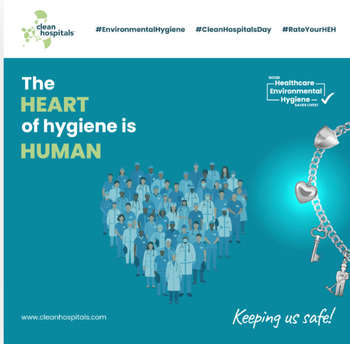
Environmental Hygiene: Air Pressure and Ventilation: Negative vs Positive Pressure
Learn more about how effective air pressure regulation in health care facilities is crucial for controlling airborne pathogens like tuberculosis and COVID-19, ensuring a safer environment for all patients and staff.
Environmental hygiene must be considered when determining the layout of a health care facility. Structural features such as ventilation systems and air pressure regulation are critical aspects that can control the spread of numerous pathogenic airborne diseases. Pressure differences can prevent contaminated air from traveling to high-risk areas with vulnerable and immunocompromised patients. Regulation of air through pressure differences is essential in health care facilities to promote a safe patient environment.
Airborne Diseases
One pathogenic microorganism that must be considered for ventilation in a health care facility is Mycobacterium tuberculosis (Mtb), an airborne disease that can be spread through droplet nuclei.1 Mtb particles range from 1 to 5 microns in size and can last in the air for several hours.2 Due to their size and ability to survive in the air for extended periods, Mtb particles can be hazardous to immunocompromised patients. In the 2023 Global Tuberculosis Report by the World Health Organization, it was noted that Mtb was the leading cause of death for people diagnosed with HIV.3 Therefore, it is important to regulate air pressure within facilities to prevent Mtb patients from spreading the disease throughout the hospital while protecting them from other airborne diseases.
Unfortunately, Mtb is not the only pathogen that can travel and remain in the air for an extended period. COVID-19 is a viral airborne infectious pathogen that can remain in the air for hours.4 Although many controls have been implemented to reduce the impacts of COVID-19, one necessary mitigation is utilizing air pressure and ventilation systems. The central concept behind using air pressure to aid in environmental hygiene is to move air in a clean-to-less-clean direction.5 This strategy applies not only to COVID-19 but also to Mtb and other airborne diseases that travel throughout health care facilities.
Positive vs Negative Pressure
Pressure differentials between rooms can help move air from clean to less clean areas. Controlling the pressure within these rooms can be accomplished using a heating, ventilation, and air conditioning system. When a positively pressurized room is adjacent to a negatively pressurized room, the air will flow from positive to negative. The American Society for Healthcare Engineering (ASHE) distinguishes between positive and negative pressurized rooms by stating, “Positively pressurized rooms are usually designed to protect a patient, clean supplies, or equipment within the room. Negative pressure is used to contain airborne contaminants within a room”.6 Understanding which rooms will contain infected patients and surgical instruments in contrast to which rooms will contain immunocompromised patients is crucial for patient safety.
Design Considerations
Regulation of air pressure is essential in sterile processing departments because this is where reusable surgical instrumentation and medical devices are reprocessed between patient use. It is critical to separate the decontamination side of the department from the assembling and sterilization areas to avoid contaminating disinfected and sterilized instrumentation. Although these department areas are generally divided, most departments will have a passthrough window for specific pieces of instrumentation that would be damaged in a washer-disinfector, such as specific fiberoptic instruments. However, because this also allows airflow between the 2 areas, it is also critical to have air pressure regulations between them. ASHE recommends that the clean side of a sterile processing department (SPD) is positively pressured, whereas the decontamination side of the SPD is negatively pressured,6 preventing contamination.
ASHE guidelines recommend that operating rooms stay in a state of positive pressure.6 This ensures that potentially infectious air from the surrounding hallways does not flow into the operating room, where immunocompromised patients could be particularly vulnerable to infection. In exceptional cases where patients infected with airborne diseases (such as Mtb) need emergency surgery, additional environmental hygiene measures must be implemented. Since operating rooms are generally positively pressured, there is potential for airborne diseases from infected patients to travel from the operating room to adjacent corridors. Measures such as portable HEPA filters and redirecting airflow to the outside environment are often considered to prevent this.1 As discussed previously, environmental hygiene needs to be a priority within the varying rooms of a health care facility to protect not only infected patients from spreading diseases but also immunocompromised patients from contracting diseases.
Summary
Regulating air pressure within health care facilities is critical to managing the airborne transmission of tuberculosis, COVID-19, and other pathogenic diseases. These diseases and other airborne pathogens can critically impact patients and pose a risk to everyone in a healthcare facility. Due to their size and ability to remain in the air for extended periods, redirecting airflow is essential to lower the risk of infection throughout the facility. Prioritizing environmental hygiene measures contributes to a safe environment for all patients.
References:
- Air. Infection Control Today. Published December 21, 2023. CDC. Accessed July 25, 2024.
https://www.cdc.gov/infection-control/hcp/environmental-control/air.html# - Clinical overview of tuberculosis. Tuberculosis (TB). CDC. Published May 8, 2024.
https://www.cdc.gov/tb/hcp/clinical-overview/index.html# - Global Tuberculosis Report 2023. World Health Organization.
https://cdn.who.int/media/docs/default-source/hq-tuberculosis/global-tuberculosis-report-2023/global-tb-report-2023-factsheet.pdf?sfvrsn=f0dfc8a4_4&download=true - Indoor air and coronavirus (COVID-19). US Environmental Protection Agency. Published May 6, 2024.
https://www.epa.gov/indoor-air-quality-iaq/indoor-air-and-coronavirus-covid-19#:~:text=Transmission%20of%20COVID%2D19%20from,for%20hours%20in%20some%20cases . - Community, work, and school. CDC. Published February 11, 2020.
https://www.cdc.gov/coronavirus/2019-ncov/community/ventilation.html - Barrick JR, Holdaway RG. Mechanical Systems Handbook for Health Care Facilities. ASHE; 2014.
https://www.ashe.org/compliance/ec_02_05_01/01/roompressurization
Newsletter
Stay prepared and protected with Infection Control Today's newsletter, delivering essential updates, best practices, and expert insights for infection preventionists.





